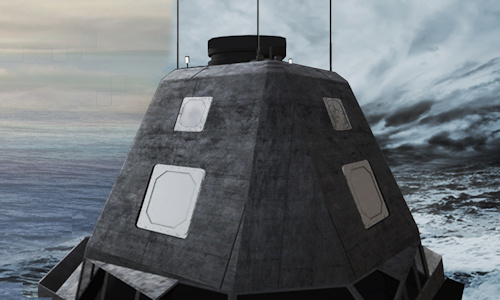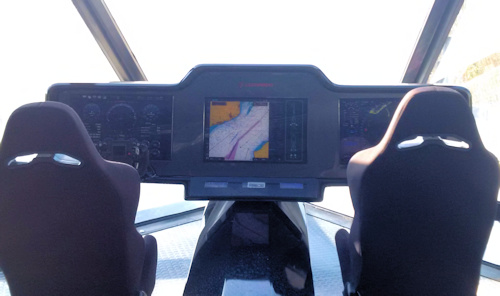The renewal of the Italian naval fleet, which passes through the named program Naval Law, presents new and advanced solutions in the field of defense electronic systems that Leonardo is carrying out. We had the opportunity to get to know closely the systems being produced and validated at the sites of Bacoli and Arco Felice and Roma Tiburtina di Leonardo.
One of the most technologically innovative systems that will equip the Multi-purpose high-altitude units of the Italian Navy is represented by the KRONOS Dual Band radar, a new multifunctional Active Electronically Scanned Array radar with four fixed faces in C band and four in X band that work in an integrated bi-band way (Dual Band Radar DBR). The DBR guarantees unmatched radar coverage to naval units. The first of these systems will equip the first multipurpose offshore patrol vessel in full mode, scheduled for 2024. The DBR will be placed in the new deckhouse configuration of the new naval units. In addition to the KRONOS DBR, currently in production at the Fusaro site and under test at Rome Tiburtina, the Multipurpose Offshore Patrol boats will also host the new NA30S MK2 multi-sensor shooting control radar, sensors such as the IFF (Identification Friend & Foe) of new generation with compliant circular antenna and the innovative static IRST (InfraRed Search and Track), an infrared sensor for the search and tracking of targets, based on multiple non-rotating optical heads, distributed on the four sides of the ship for an uninterrupted 360-degree view, and an Electronic Warfare EW, and finally the latest generation of integrated communications systems. In fact, a new integrated communication system has been developed which also includes innovative ones Software Defined Radio, in addition to multiband satellite systems.
 In particular, the DBR represents the synthesis between the radar capabilities offered by the C band, capable of intercepting airborne threats, of carrying out medium and long range surveillance and tracking of possible targets and the capabilities of the X band, capable of tracking threats surface and short-range. The C band radar sensor is a multifunctional derivative system of the new KRONOS family of Leonardo, with respect to which it provides an enhancement of active antenna modules and an extended set of functions, especially in the ATBM (Anti-Tactical Ballistic Missile) mode. independent research and external designation. As for the rotating version, it is equipped withup-link for ASTER15 / 30 / 30 B1 NT missiles. The system, unlike rotary single-sided versions, with the distribution of radar activities on four fixed faces, determines an increase in the quantifiable performance of discovery in a factor almost equal to three. The X-band sensor is a multifunctional radar (for the PPA version and, too represents the only primary radar sensor) for aerial and surface surveillance, composed of 4 fixed panels that allow electronic scanning of the beam both in azimuth, to obtain the 360 ° of azimuth coverage, and in elevation up to the zenith. The system is able to detect both fast approaching threats (subsonic and supersonic sea skimmer missiles) from the optical horizon that traditional threats such as aircraft, helicopters and naval platforms of various sizes. The radar can also be used for cannon control like back-up in case of unavailability of the dedicated shot control radar thanks to the high accuracy typical of the X band. The electronically scanned IFF radar, fully compatible with the S mode and the 5 mode, is derived from the analog radar phased array installed on the aircraft carrier Cavour and on the FREMM frigates, replacing the current six faces with a cylindrical antenna. The IRST, the new electro-optical system, which provides the TV and infrared display, will have automatic tracking, considerable coverage in elevation, can perform panoramic video and automatic recording. The data-link and satellite communication system is also an integrated solution of VHF / UHF radio, 16 links, telephone and satellite communications.
In particular, the DBR represents the synthesis between the radar capabilities offered by the C band, capable of intercepting airborne threats, of carrying out medium and long range surveillance and tracking of possible targets and the capabilities of the X band, capable of tracking threats surface and short-range. The C band radar sensor is a multifunctional derivative system of the new KRONOS family of Leonardo, with respect to which it provides an enhancement of active antenna modules and an extended set of functions, especially in the ATBM (Anti-Tactical Ballistic Missile) mode. independent research and external designation. As for the rotating version, it is equipped withup-link for ASTER15 / 30 / 30 B1 NT missiles. The system, unlike rotary single-sided versions, with the distribution of radar activities on four fixed faces, determines an increase in the quantifiable performance of discovery in a factor almost equal to three. The X-band sensor is a multifunctional radar (for the PPA version and, too represents the only primary radar sensor) for aerial and surface surveillance, composed of 4 fixed panels that allow electronic scanning of the beam both in azimuth, to obtain the 360 ° of azimuth coverage, and in elevation up to the zenith. The system is able to detect both fast approaching threats (subsonic and supersonic sea skimmer missiles) from the optical horizon that traditional threats such as aircraft, helicopters and naval platforms of various sizes. The radar can also be used for cannon control like back-up in case of unavailability of the dedicated shot control radar thanks to the high accuracy typical of the X band. The electronically scanned IFF radar, fully compatible with the S mode and the 5 mode, is derived from the analog radar phased array installed on the aircraft carrier Cavour and on the FREMM frigates, replacing the current six faces with a cylindrical antenna. The IRST, the new electro-optical system, which provides the TV and infrared display, will have automatic tracking, considerable coverage in elevation, can perform panoramic video and automatic recording. The data-link and satellite communication system is also an integrated solution of VHF / UHF radio, 16 links, telephone and satellite communications.

Electronic warfare systems allow the electromagnetic emissions of enemy devices to be analyzed using the ESM (Electronic Support Measures) with the aim, not only to have another mode of discovery, but also to intentionally create the most appropriate disturbances.
Un system manager realized by Leonardo will integrate all the fixed-face radar sensors and the electronic warfare devices (EW), offering significant operational advantages compared to the conventional approach, reducing the conflicts between radar and electronic warfare activities that occur in the most traditional. Thanks to this new solution it will be possible to defend more effectively a naval force against airplanes with increasingly reduced radar section (stealth), detect missiles and contribute to the discovery / tracking / neutralization of ballistic missiles (TBM, Tactical Ballistic Missile), hit targets on the coast, providing support fire to ground troops and effectively manage asymmetric (surface and airborne) threats.
The all-round capabilities guaranteed by all these new systems, which will be integrated into the naval units, will be finally managed through ATHENA, the Combat Management System, an advanced next generation command and control system, with open architecture capable of guaranteeing the best acquisition, merging and data management capabilities for an effective evaluation of operational scenarios and for the management of available resources, thus ensuring rapid and effective decision-making processes.
The CMS will be installed in the new naval cockpit developed by Leonardo together with Fincantieri. This is an advanced control system for the entire ship, like an aeronautical cockpit, a sort of "Integrated Ship-Ship Station", which will allow, for the first time, to manage the operations related to both the operation of the ship in an integrated manner. both to the combat system, with a reduced number of operators thanks to the use of new augmented reality technologies.
(photo: Marina Militare / Leonardo)












